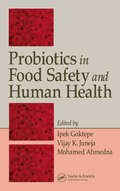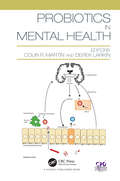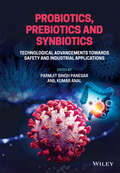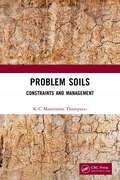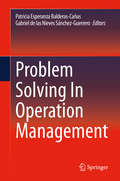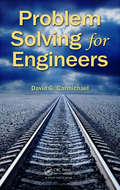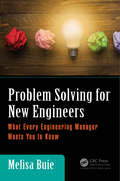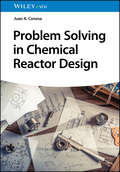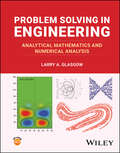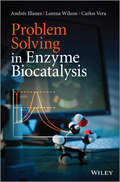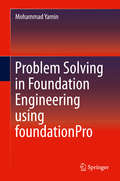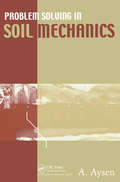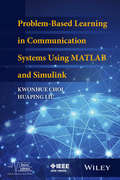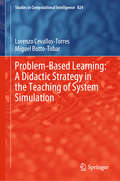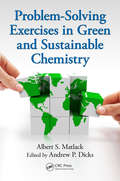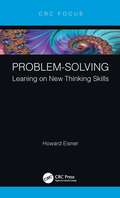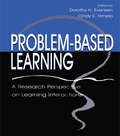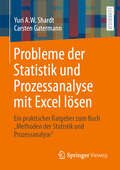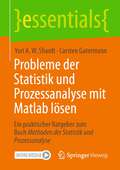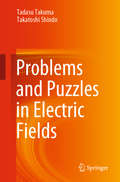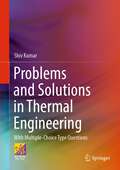- Table View
- List View
Probiotics in Food Safety and Human Health
by Vijay K. Juneja Ipek Goktepe Mohamed AhmednaThe discovery of new and previously unknown organisms that cause foodborne illness makes it essential for scientists, regulators, and those in the food industry to reconsider their traditional approaches to food preservation. A single source reference that can provide the latest practical information on how to deal with the range of probiotic healt
Probiotics in Mental Health
by Colin R. Martin Derek LarkinThe concept that the gut and brain are intricately linked is widely accepted not just within the lay community but increasingly within scientific and therapeutic circles as well. Terms such as "heartache" and "gut wrenching" are more than mere metaphor, they represent key fundamental aspects of human experience which all individuals will invariably endure from time to time. The relationship between the gut and brain is complex but fundamental to health and wellbeing. Increasing and compelling evidence supports the existence of a relationship between the health and status of the gut and the manifestation of significant psychopathology. Uniquely within the field of mental health and psychiatry, the role of gut flora and probiotics in both the understanding and treatment of mental illness represents an emerging science whether the potential for therapeutic intervention, through the use of probiotics, offers an opportunity to determine efficacy within a coherent evidence-based model of both action and pathology or, moreover, offers interventions that are comparatively benign compared to the side-effect profile associated with most drugs used to treat mental illness. <P><P>Probiotics in Mental Health examines the role of probiotics in a range of clinical presentations associated with significant psychopathology and facilitates a reconsideration of how mental illness may be conceptualised within a coherent gut-brain model of health and wellbeing. Under the rubric of enhancing wellbeing rather than dwelling on illness and disease, this exciting new volume not only comprises the latest evidence in the field but also advocates an approach characterised by the understanding of mental disorder within an evidence-based model and the pursuit of mental health and wellbeing through the most benign of interventions.
Probiotics, Prebiotics and Synbiotics: Technological Advancements Towards Safety and Industrial Applications
by Anil Kumar Anal Parmjit Singh PanesarIn Probiotics, Prebiotics and Synbiotics: Technological Advancements Towards Safety and Industrial Applications, a team of distinguished researchers delivers an insightful exploration of various aspects of functional foods. The book includes information about critical facets of the production of these beneficial compounds, recent technological developments in the field, and their present and future commercial potential. The authors describe their mechanisms of action and their applications in several sectors. Probiotics, Prebiotics and Synbiotics is divided into five parts. A general introduction about these substances begins the book and is followed by discussions of common probiotics, prebiotics, and synbiotics. Finally, a treatment of safety issues and regulatory claims, as well as their market potential, rounds out the resource. Perfect for researchers, industry practitioners, and students working in or studying food processing and food microbiology, Probiotics, Prebiotics and Synbiotics is also an invaluable resource for professionals working in the field of food biotechnology.
Probiotics, the Natural Microbiota in Living Organisms: Fundamentals and Applications (Industrial Biotechnology)
by Shang-Tian Yang Hesham Ali El-EnshasyBeneficial microbes called probiotics exist naturally in our bodies and play a vital role in our health. Probiotics have been known to produce important microbiota of antimicrobial compounds that enhance our immunity to counter the harmful effects of pathogenic organisms. These microbes are also used in the treatment of diseases and in negating the side effects of chemically synthesized medicines. The study of probiotic organisms and their wide applications in industrial products for human and animal uses has thus gained momentum. This book provides a comprehensive review on the research and applications of probiotics. It serves as a reference and resource for undergraduate and postgraduate students, researchers, companies, and policy makers who are active in fields related to functional food and feed, industrial biotechnology, nutraceuticals, and medicine. All chapters in this book have been written and edited by leading experts in the respective fields from academia, industry, or government.
Problem Soils: Constraints and Management
by K C ThampattiThis is a unique book that deals with the problem soils, their constraints and management in the Indian context. The book starts with the introduction on problem soils and the classification of these soils are included there under. In India, there is wide spread occurrence of soils with different types of constraints for crop production. Such soils are popularly called as “Problem Soils”. Cultivation in these soils is not so easy as several problems have to be tackled during cultivation. It may be either soil droughtiness or acidity or salinity etc. An attempt has been made in this book to cover most of the problematic soils in India. The classification of problem soils has been done based on the limitations they possess and the most dominant limitation is taken into consideration for grouping it under a particular class. Here five broader classes have been identified viz., soils with climatic problems; soils with physical problems; soils with chemical problems; soils with biological problems and soils with problems due to anthropogenic reasons.
Problem Solving Approaches for Maintaining Operational Excellence in Process Plants
by Joseph M. Bonem Nattapong Pongboot Wiroon TanthapanichakoonComprehensive reference providing methods for process engineers and operators to solve challenging process problems and develop working hypotheses for typical process equipment Problem Solving Approaches for Maintaining Operational Excellence in Process Plants provides a template for achieving an enhanced level of operating efficiency in chemical processing plants and refineries. With examples included throughout to demonstrate key concepts, this book includes methods for formulating working hypotheses for typical process equipment such as pumps, compressors, heat exchangers/furnaces, fractionating towers, and reactors, with additional information on defining and setting metrics and the application of the techniques in unusual situations, as well as the application of these techniques in view of commercially available computer simulation programs. This book covers topics including initial considerations in problem solving, basic steps in problem solving, and verification of process instrument data, with solved problems showing how techniques can be applied to prime movers, plate processes, kinetically limited processes, and unsteady state problems. This newly revised and updated Second Edition includes coverage of the latest research and developments in the field. Written by a team of highly qualified industry professionals, Problem Solving Approaches for Maintaining Operational Excellence in Process Plants includes discussion on: Lumped parameters as the ideal approach to determine values for key performance indicators (KPIs)Theoretical KPIs in comparison to actual operation as a method to find “hidden problems”Situations where experience-based solutions are unavailable due to lack of technically trained personnelSolutions to problems where a previous analysis has confirmed a need for new equipment or enhanced operating proceduresDigital twins and their usefulness in predicting yields, executing plant operations, and training operating and technical personnel Problem Solving Approaches for Maintaining Operational Excellence in Process Plants is an essential reference on the subject for chemical engineers, industrial engineers, process operators, process shift supervisors, chemical engineers with minimal exposure to industrial calculations, and industrial managers who are looking for techniques to improve organization problem solving skills.
Problem Solving In Operation Management
by Patricia Esperanza Balderas-Cañas Gabriel de las Nieves Sánchez-GuerreroThis volume examines problem solving and applied systems aimed at improving performance and management of organizations. The book’s eight chapters are integrated into two parts: methodologies and techniques that discuss complex dynamic analysis of the organizations, participative processes for building trend scenarios, consultancy as a systemic intervention process, processes to promote innovative goals in organizations, and analytical processes and solid mathematical representation systems. The authors also include a model to urban parks location, an analytic model to urban services location, and a system to forecast demand with fussy sets.Describes methodologies to analyze processes in complex dynamic organizations, including as participative, interventional, innovative, and analytical approaches;Clarifies a strategies for providing structure to complex organizations and applying analytical methods to decision making;Illustrates problem holistic solving strategies;Explains how to approach several problems from a holistic point of view and how analyze the subjacent processes to make decisions.
Problem Solving for Engineers
by David G. CarmichaelThis book takes a systematic approach to problem definition, generation of alternative solutions, analysis, and selection of the preferred solution. The book introduces fundamental terms needed to think systematically and undertake systematic problem solving and covers individual and group problem solving. It discusses the selection of the preferred solution involves decision making and fundamental concepts of decision making, including decision making in the presence of multiple criteria and uncertainty. The treatment embodies decision making for sustainability, with its blend of economics, social, and environmental considerations.
Problem Solving for New Engineers: What Every Engineering Manager Wants You to Know
by Melisa BuieThis book brings a fresh new approach to practical problem solving in engineering, covering the critical concepts and ideas that engineers must understand to solve engineering problems. Problem Solving for New Engineers: What Every Engineering Manager Wants You to Know provides strategy and tools needed for new engineers and scientists to become apprentice experimenters armed only with a problem to solve and knowledge of their subject matter. When engineers graduate, they enter the work force with only one part of what’s needed to effectively solve problems -- Problem solving requires not just subject matter expertise but an additional knowledge of strategy. With the combination of both knowledge of subject matter and knowledge of strategy, engineering problems can be attacked efficiently. This book develops strategy for minimizing, eliminating, and finally controlling unwanted variation such that all intentional variation is truly representative of the variables of interest.
Problem Solving for Process Operators and Specialists
by J. M. BonemThis book provides methods to train process operators to solve challenging problems. The book is split into two parts. The first part consists of two parts; first developing a daily monitoring system and second providing a structured 5 step problem solving approach that combines cause and effect problem solving thinking with the formulation of theoretically correct hypotheses. The 5 step approach emphasizes the classical problem solving approach (defining the sequence of events) with the addition of the steps of formulating a theoretically correct working hypothesis, providing a means to test the hypothesis, and providing a foolproof means to eliminate the problem. The initial part of the book focuses on defining the problem that must be solved and obtaining the location, time and quantity based specifications of the problem. This part of the book also presents techniques to find and define problems at an early point before they progress to the critical level.The second part of the book deals with the utilization of fundamental chemical engineering skills to develop a technically correct working hypothesis that is the key to successful problem solving. The primary emphasis is on simple pragmatic calculation techniques that are theoretically correct. It is believed that any operator can perform these calculations if he is provided the correct prototype. Throughout the book, the theory behind each pragmatic calculation technique is explained in understandable terms prior to presenting the author's approach. These techniques have been developed by the author in 50+ years of industrial experience. The book includes many sample problems and examples of real world problem solving. Using these techniques, theoretically correct working hypotheses can be developed in an expedient fashion.
Problem Solving in Chemical Reactor Design
by Juan A. ConesaExtensive workbook with more than 200 up-to-date solved problems on advanced chemical reactors for deeper understanding of chemical reactor design Problem Solving in Chemical Reactor Design provides in-depth coverage of more than 200 solved complex reactor design problems extracted from core chemical engineering subject areas. The problems in this book cover the design of non-ideal, catalytic, multiphase, heterogeneous, and biochemical reactors rather than focusing on basic Chemical Reactor Engineering concepts. Each complex problem is solved using simple procedures and mathematical tools, enabling readers to better understand the correct procedure for solving problems and solve them faster, more conveniently, and more accurately. This book is inspired by more than two decades of the author's teaching experience in chemical reactor engineering. Accompanying electronic materials include spreadsheets and easily understandable Matlab® programs, which can both be downloaded from the Wiley website. Some of the topics covered in Problem Solving in Chemical Reactor Design include: Optimization, operation, and complexities of reactor design in the face of non-idealities such as mixing issues and residence time distributions Utilization of the tanks-in-series model, dispersion model, and intricate combinations of ideal reactors to elucidate the impact on conversion rates Signal processing within the domain of chemical reactor engineering, specifically focusing on convolution and deconvolution methodologies Reaction kinetics, diffusion dynamics, and catalyst efficiency in catalytic reactor design, and design of gas-catalytic and gas-liquid-solid catalyst systems in multiphase reactors Problem Solving in Chemical Reactor Design is an excellent learning resource for students and professionals in the fields of chemical engineering, pharmaceuticals, biotechnology, and fine chemistry.
Problem Solving in Engineering: Analytical Mathematics and Numerical Analysis
by Larry A. GlasgowBring mathematical principles to bear on engineering problems with this updated text The evolution of industrial processes has resulted in greater emphasis upon analytical and numerical problem solving. Process improvement through experimentation is impractical and consequently engineers must rely upon computational and technical analysis. Furthermore, the ease with which time-series data can be collected and processed has made harmonic signal interpretation routine. Thus, the ability of engineers to analyze, model, compute, and interpret process phenomena is crucial to professional practice. Problem Solving in Engineering meets these needs with a foundational introduction to mathematical techniques in applied sciences and engineering. Incorporating examples from a range of scientific fields, it communicates principles that can be adapted to many hardware-software combinations. Now fully updated to reflect the latest research and applications, it remains an essential tool for engineers and applied scientists everywhere. Readers of the second edition will also find: Extensive time devoted to problem formulationDetailed discussion of integro-differential equations and the processing and analysis of time-series dataThe use of vorticity transport for the solution of momentum, heat, and mass transfer problems in two dimensionsExamples and problems drawn from aviation, telegraphy, structural failures, railroad operation, chemical processes, automatic process control, seismology, neutron diffusion, gravitation, and quantum theoryMany additional narrative-type exercises written to appeal to students who find problems in context better suited to their learning styleSolutions manual available for qualified instructors Problem Solving in Engineering is ideal for advanced undergraduate, graduate students, and technical professionals in the physical sciences, specifically chemical, civil, biochemical, electrical, and mechanical engineering, as well as physics, chemistry, and biology.
Problem Solving in Enzyme Biocatalysis
by Carlos Vera Lorena Wilson Andrés IllanesEnzyme biocatalysis is a fast-growing area in process biotechnology that has expanded from the traditional fields of foods, detergents, and leather applications to more sophisticated uses in the pharmaceutical and fine-chemicals sectors and environmental management. Conventional applications of industrial enzymes are expected to grow, with major opportunities in the detergent and animal feed sectors, and new uses in biofuel production and human and animal therapy.In order to design more efficient enzyme reactors and evaluate performance properly, sound mathematical expressions must be developed which consider enzyme kinetics, material balances, and eventual mass transfer limitations. With a focus on problem solving, each chapter provides abridged coverage of the subject, followed by a number of solved problems illustrating resolution procedures and the main concepts underlying them, plus supplementary questions and answers.Based on more than 50 years of teaching experience, Problem Solving in Enzyme Biocatalysis is a unique reference for students of chemical and biochemical engineering, as well as biochemists and chemists dealing with bioprocesses.Contains: Enzyme properties and applications; enzyme kinetics; enzyme reactor design and operation 146 worked problems and solutions in enzyme biocatalysis.
Problem Solving in Foundation Engineering using foundationPro
by Mohammad YaminThis book is at once a supplement to traditional foundation engineering textbooks and an independent problem-solving learning tool. The book is written primarily for university students majoring in civil or construction engineering taking foundation analysis and design courses to encourage them to solve design problems. Its main aim is to stimulate problem solving capability and foster self-directed learning. It also explains the use of the foundationPro software, available at no cost, and includes a set of foundation engineering applications. Taking a unique approach, Dr. Yamin summarizes the general step-by-step procedure to solve various foundation engineering problems, illustrates traditional applications of these steps with longhand solutions, and presents the foundation Pro solutions. The special structure of the book allows it to be used in undergraduate and graduate foundation design and analysis courses in civil and construction engineering. The book stands as valuable resource for students, faculty and practicing professional engineers. This book also: Maximizes reader understanding of the basic principles of foundation engineering: shallow foundations on homogeneous soils, single piles, single drilled shafts, and mechanically stabilized earth walls (MSE) Examines bearing capacity and settlement analyses of shallow foundations considering varying elastic moduli of soil and foundation rigidity, piles, and drilled shafts Examines internal and external stabilities of mechanically stabilized earth walls with varying horizontal spacing between reinforcing strips with depth Summarizes the step-by-step procedure needed to solve foundation engineering problems in an easy and systematic way including all necessary equations and charts
Problem Solving in Soil Mechanics
by A. AysenWritten for university students taking first-degree courses in civil engineering, environmental and agricultural engineering, Problem Solving in Soil Mechanics stimulates problem-solving learning as well as facilitating self-teaching. Generally assuming prior knowledge of subject, necessary basic information is included to make it accessible to readers new to the topic. Filled with worked examples, new and advanced topics and with a flexible structure that means it can be adapted for use in second, third and fourth year undergraduate courses in soil mechanics, this book is also a valuable resource for the practising professional engineer as well as undergraduate and postgraduate students. Primarily designed as a supplement to Soil Mechanics: Basic Concepts and Engineering Applications, this book can be used by students as an independent problem-solving text, since there are no specific references to any equations or figures in the main book.
Problem Structuring: Methodology in Practice
by Mike YearworthCurrent perspectives on approaches to problem structuring in operational research and engineering and prospects for problem structuring methods applicable to a wide range of practice. Bridging between operational research (OR) and engineering practice, Problem Structuring: Methodology in Practice is grounded in the emergence of soft OR and its development over time as a distinctively new field, broadening the scope of OR to deal with issues of transforming, strategising, and planning in the context of wicked problems. The book is centred on a methodological framing of intervention processes known as problem structuring methods (PSMs) and the techniques presented are suitable for practitioners across a broad range of disciplines. Written by a highly qualified professor of engineering and management, Problem Structuring: Methodology in Practice contains four linked sections that cover: I. Problem formulation when dealing with wicked problems, justification for a methodological approach, the emergence of soft OR, the relevance of pragmatic philosophy to OR practice. II. Traces debates and issues in OR leading to the emergence of soft OR, comparative analysis of PSMs leading to a generic framework for soft OR practice, addressing practical considerations in delivering PSM interventions. III. Charts the emergence of a problem structuring sensibility in engineering practice, introduces a new PSM based on hierarchical process modelling (HPM) supported by teaching and case studies, makes the case for a processual turn in engineering practice supported by HPM with relevance to OR practice. IV. Evaluation of PSM interventions, survey of applications, use of group support systems, new developments supported by machine learning, recontextualising soft OR practice. Problem Structuring: Methodology in Practice is a thought-provoking and highly valuable resource relevant to all “students of problems.” It is suitable for any UK Level 7 (or equivalent) programme in OR, engineering, or applied social science where a reflective, methodological approach to dealing with wicked problems is an essential requirement for practice.
Problem-Based Learning in Communication Systems Using MATLAB and Simulink
by Huaping Liu Kwonhue ChoiDesigned to help teach and understand communication systems using a classroom-tested, active learning approach.<P><P> * Discusses communication concepts and algorithms, which are explained using simulation projects, accompanied by MATLAB and Simulink<P> * Provides step-by-step code exercises and instructions to implement execution sequences<P> * Includes a companion website that has MATLAB and Simulink model samples and templates
Problem-Based Learning: A Didactic Strategy in the Teaching of System Simulation (Studies in Computational Intelligence #824)
by Miguel Botto-Tobar Lorenzo Cevallos-TorresThis book describes and outlines the theoretical foundations of system simulation in teaching, and as a practical contribution to teaching-and-learning models. It presents various methodologies used in teaching, the goal being to solve real-life problems by creating simulation models and probability distributions that allow correlations to be drawn between a real model and a simulated model. Moreover, the book demonstrates the role of simulation in decision-making processes connected to teaching and learning.
Problem-Solving Exercises in Green and Sustainable Chemistry
by Andrew P. Dicks Albert S. MatlackWhen confronted with a problem in science, the way to proceed is not always obvious. The problem may seem intractable or there may be many possible solutions, with some better than others. Problem-Solving Exercises in Green and Sustainable Chemistry teaches students how to analyze and solve real-world problems that occur in an environmental context
Problem-Solving: Leaning on New Thinking Skills
by Howard EisnerProblem-solving and better thinking skills are among the top skills that employers are looking for. This book presents various methods of problem-solving that can be adapted to any field. It focuses on a set of a dozen new approaches with an ending result to finding better solutions to problems that you may have previously found difficult. The book discusses problem-solving based upon new thinking skills and presents the relationship between problem-solving and creativity. A connection between problem-solving and re-engineering is presented as the book explores the ability to tackle new and difficult problems in all aspects of life. It points you in the direction of how to easily find better solutions to problems that previously were found to be difficult. Target audience is general engineers, systems engineers, scientists, technologists, mathematicians, and lawyers.
Problem-based Learning: A Research Perspective on Learning Interactions
by Cindy E. Hmelo-Silver Dorothy H. Evensen Cindy E. HmeloThis volume collects recent studies conducted within the area of medical education that investigate two of the critical components of problem-based curricula--the group meeting and self-directed learning--and demonstrates that understanding these complex phenomena is critical to the operation of this innovative curriculum. It is the editors' contention that it is these components of problem-based learning that connect the initiating "problem" with the process of effective "learning." Revealing how this occurs is the task taken on by researchers contributing to this volume. The studies include use of self-reports, interviews, observations, verbal protocols, and micro-analysis to find ways into the psychological processes and sociological contexts that constitute the world of problem-based learning.
Probleme der Statistik und Prozessanalyse mit Excel lösen: Ein praktischer Ratgeber zum Buch "Methoden der Statistik und Prozessanalyse"
by Yuri A.W. Shardt Carsten GatermannDieser praktische Ratgeber zum Buch „Methoden der Statistik und Prozessanalyse – Eine anwendungsorientierte Einführung“ gibt einen kompakten Überblick über die Nutzung von Excel zur Lösung typischer statistischer Fragestellungen. Neben kurzen Theorieteilen liegt der Fokus des Buchs auf detailliert dargestellten Excel Beispiele zur Lösung der Aufgaben. Weiterhin werden typische Abläufe für Standardaufgaben in Excel vorgestellt und erklärt. Kontrollfragen am Ende jedes Kapitels ermöglichen dem Lesenden, das erworbene Wissen selbstständig zu testen.
Probleme der Statistik und Prozessanalyse mit Matlab lösen: Ein praktischer Ratgeber zum Buch Methoden der Statistik und Prozessanalyse (essentials)
by Yuri A.W. Shardt Carsten GatermannDieser praktische Ratgeber zum Buch Methoden der Statistik und Prozessanalyse – Eine anwendungsorientierte Einführung gibt einen kompletten Überblick über die Nutzung von MATLAB zur Lösung typischer statistischer Fragestellungen. Neben kurzen Theorieteilen liegt der Fokus des Buchs auf detailliertem, Zeile für Zeile dargestelltem MATLAB Code zur Lösung der Aufgaben. Weiterhin werden typische Abläufe für Standardaufgaben in MATLAB vorgestellt und erklärt. Kontrollfragen am Ende jedes Kapitels ermöglichen dem Leser, das erworbene Wissen selbstständig zu testen.
Problems and Puzzles in Electric Fields
by Tadasu Takuma Takatoshi ShindoThis book aims at making readers develop a better understanding of electrostatic fields using the form of problems and puzzles (summarized as “questions” hereafter) and answers, instead of tedious explanations in ordinary textbooks. The book is filled with the questions with unexpected answers and questions often misunderstood or rarely completely understood, most of which are original. The questions in the book look simple and very easy to answer at a glance; nevertheless, once students try to solve them, they will find that the questions are really tough nuts to crack. Teachers can also use the questions in the book in their classes.Not only from an academic or an educational point of view, the book is useful also to engineers working in such fields as electrical discharges and their applications, high voltage equipment in DC and AC circuits as well as electrostatic devices. This is because the book introduces various practical applications related to electrostatic fields.The original ideas of the book are based on the following Japanese book written by one of author; T. Takuma: Panorama of Electric Fields (in Japanese) IEE, Japan, 2003. This English version of the book has been thoroughly revised and improved with several new questions added.
Problems and Solutions in Thermal Engineering: With Multiple-Choice Type Questions
by Shiv KumarThis book is a collection of over 225 multiple choice type questions (MCQs) and more than 40 practice/exam questions with solutions. This book complements a 2-volume textbook set titled Thermal Engineering by the same author. The answers are adequately supported by well-illustrated diagrams wherever necessary for better understanding of the concepts. The book also included steam tables as an appendix to aid in problem solving .This book proves useful for undergraduate students of mechanical engineering and related disciplines. The book is used in conjunction with the author's textbook set on thermal engineering or as a supplement to other core textbooks and lecture materials. It is used to support classroom teaching or as a self-study guide. The problem-solution format also proves useful for students and professionals involved in exam prep for graduate university entrance tests and professional certifications.
